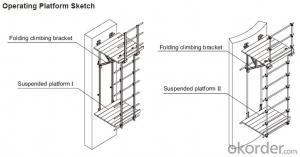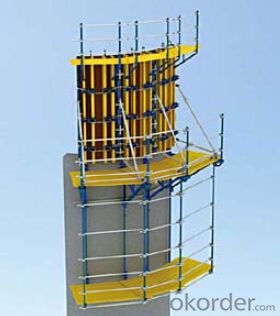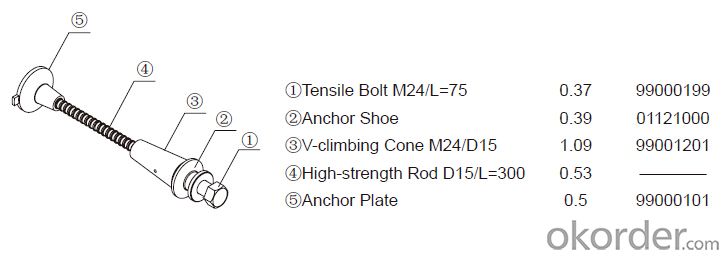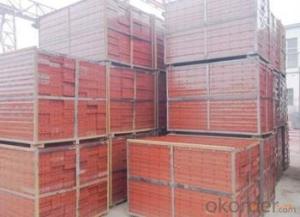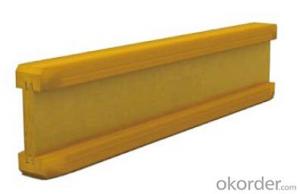Climbing Platform CP-190 for formwork and scaffolding system
- Loading Port:
- Tianjin
- Payment Terms:
- TT OR LC
- Min Order Qty:
- 50 m²
- Supply Capability:
- 1000 m²/month
OKorder Service Pledge
OKorder Financial Service
You Might Also Like
Climbing Platform CP190
Climbing bracket CP190 is mainly used as operating platform during construction. It can be used
on the vertical wall and arced wall. The bracket hang on the anchor system and all the load are
supported by anchor system. It’s convenient to assemble and dismantle, the construction is easy,
rapid and safe.
Anchor System:
Anchor system is the most important supporting part. The system is made of five parts shown
below. There into, tensile bolt, anchor shoe and V-climbing cone can be taken out for reusing.
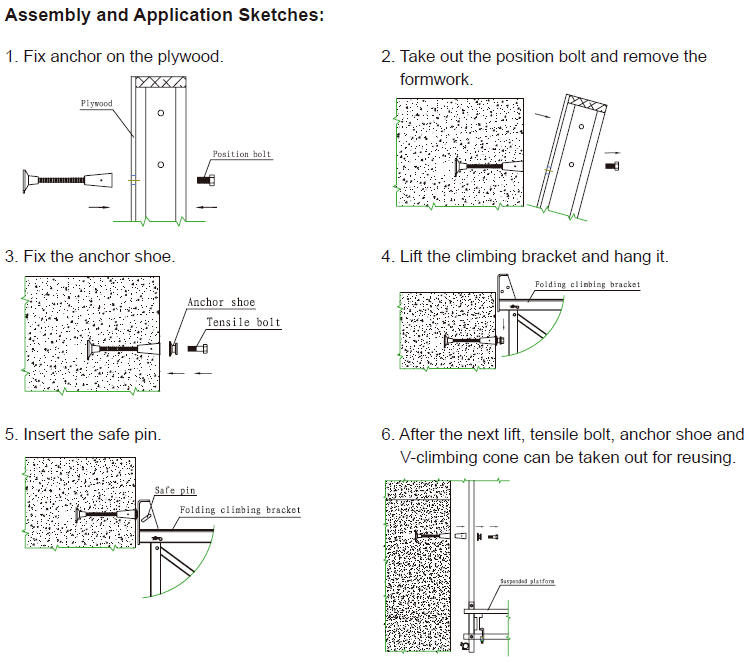
- Q: How does steel formwork contribute to the overall fire resistance of the structure?
- Steel formwork does not directly contribute to the fire resistance of a structure. However, it can indirectly enhance fire resistance by supporting the installation of fire-rated materials, such as fire-resistant coatings or insulation, which are crucial in increasing the overall fire resistance of the structure.
- Q: Are there any regulations or standards that govern the use of steel formwork?
- Steel formwork in construction projects is subject to regulations and standards to guarantee safety, quality, and durability. The American National Standards Institute (ANSI) A10.9-2013 standard is widely recognized for safety requirements in concrete and masonry construction. It provides guidelines for formwork usage, including steel formwork, covering design, construction, inspection, and maintenance. Beside ANSI, the Occupational Safety and Health Administration (OSHA) in the United States and the Health and Safety Executive (HSE) in the United Kingdom establish regulations and guidelines for safe steel formwork utilization. These regulations encompass worker safety, proper assembly and dismantling procedures, and the use of suitable protective equipment. Furthermore, international standards like ISO 9001:2015 for quality management systems are applicable to steel formwork manufacturing and installation processes. These standards guarantee that the steel formwork meets specific quality and performance criteria. Construction companies and contractors must comply with these regulations and standards to ensure worker safety and project success. Noncompliance can lead to penalties, legal issues, and on-site accidents. Consequently, staying up-to-date with the latest regulations and standards related to steel formwork is crucial and their implementation is vital.
- Q: Are there any specific maintenance requirements for steel formwork?
- Yes, there are specific maintenance requirements for steel formwork. Steel formwork is known for its durability and longevity, but regular maintenance is necessary to ensure its optimal performance and prolong its lifespan. One important maintenance requirement for steel formwork is cleaning. After each use, the formwork should be thoroughly cleaned to remove any concrete residue and prevent the buildup of corrosive agents. This can be done using water and a mild detergent, and ensuring that all surfaces are properly dried afterwards. Additionally, it is crucial to inspect the formwork for any signs of damage or wear. This includes checking for cracks, rust, or any other defects that may weaken the structure. Any damaged components should be repaired or replaced promptly to maintain the integrity and safety of the formwork. Furthermore, proper storage and handling are essential maintenance practices for steel formwork. The formwork should be stored in a dry and well-ventilated area to prevent corrosion. It should be protected from moisture, extreme temperatures, and direct sunlight. When handling the formwork, it is important to avoid any abrasive materials or tools that could cause scratches or dents. Regular lubrication of moving parts, such as hinges and locks, is also recommended to ensure smooth operation and prevent any seizing or jamming. Using a suitable lubricant will help reduce friction and extend the life of these components. Lastly, it is advisable to follow the manufacturer's guidelines and recommendations for specific maintenance requirements of the steel formwork. These guidelines may include additional steps or precautions that are specific to the particular formwork system being used. By adhering to these maintenance requirements, steel formwork can be kept in excellent condition, allowing for efficient and safe construction practices.
- Q: Can steel formwork be used for both residential and industrial projects?
- Yes, steel formwork can be used for both residential and industrial projects. It offers durability, strength, and flexibility, making it suitable for various construction applications. Steel formwork is commonly used in both residential and industrial projects for its ability to withstand heavy loads, provide a smooth finish, and ensure accurate dimensions.
- Q: Can steel formwork be used in precast concrete applications?
- Precast concrete applications can indeed utilize steel formwork. Steel, being a versatile and durable material, can withstand the pressures and forces exerted throughout the precasting process. It offers exceptional support and stability during pouring and curing, aiding in the creation of precise shapes and detailed concrete elements. This results in accurate dimensions and a top-notch finish. Moreover, steel formwork can be swiftly assembled and disassembled, making it ideal for fast-paced and repetitive precast production. Overall, due to its strength, versatility, and ease of use, steel formwork is extensively employed in precast concrete applications.
- Q: How does steel formwork handle different concrete reinforcement spacing?
- Steel formwork is able to handle different concrete reinforcement spacing by providing flexibility and adaptability in its design. The formwork is typically adjustable, allowing for the necessary spacing between reinforcement bars to be accommodated. This ensures that the concrete is poured and compacted around the reinforcement bars evenly, maintaining structural integrity and strength. Additionally, steel formwork is durable and strong, capable of withstanding the pressures exerted by the concrete and the reinforcement bars, regardless of their spacing.
- Q: What are the different types of form ties used in steel formwork systems?
- In steel formwork systems, there exist various form ties that serve to establish a secure bond between the formwork panels and supporting structures. 1. Conventional Form Ties: The most commonly employed form ties are those comprised of a steel rod with cones or washers on both ends. These rods are inserted through the formwork panels and secured using nuts or wedges, resulting in a robust connection. 2. Coil Ties: These ties are constructed from a continuous loop of wire, often galvanized to resist corrosion. They are simple to install and remove, and can accommodate different concrete wall thicknesses by adjusting the loop length. 3. She-Bolts: Alternatively referred to as she-bolts or coil bolts, these form ties consist of a threaded rod embedded in the concrete wall, along with a plate and nut on the external side. They establish a sturdy connection and find common usage in scenarios where frequent formwork removal and repositioning is necessary. 4. Snap Ties: Equipped with a flat plate on one end and a snap-tie wedge on the other, these ties are easily and swiftly installed without any special tools. They offer a dependable connection and are suitable for light to medium-duty applications. 5. Plastic Cone Ties: Designed for use with reusable plastic formwork systems, these ties are made from plastic material. They possess a lightweight nature, are easy to handle, and exhibit excellent resistance to chemical corrosion. 6. Flat Ties: Strip or bar-shaped, flat ties are utilized to connect formwork panels. Typically crafted from steel, they can be readily bent or cut to the desired length. These ties are frequently employed in scenarios where the wall thickness is minimal. 7. Wedge Bolts: Comprising a threaded rod, a wedge-shaped plate, and a nut, these form ties are inserted into a hole in the formwork panel. Tightening the nut secures the connection. Wedge bolts are commonly employed in situations requiring high strength and rapid installation. These aforementioned examples merely represent a selection of the various form ties adopted within steel formwork systems. The choice of form tie is contingent upon factors such as the application, concrete wall thickness, desired strength, and ease of installation and removal.
- Q: What are the common types of steel used for formwork?
- The common types of steel used for formwork are mild steel and high-strength steel.
- Q: What are the different accessories required for steel formwork maintenance?
- The following are the various accessories needed to maintain steel formwork: 1. To maintain the smooth surface of the formwork and prevent corrosion or damage, formwork cleaning agents are used to remove any concrete residue or build-up on the steel formwork. 2. Prior to pouring concrete, formwork release agents are applied to the steel formwork to prevent it from sticking. This makes it easier to remove the formwork once the concrete has cured. 3. Formwork patching compounds are used to fix any damages or imperfections on the steel formwork. This helps maintain the formwork's structural integrity and ensure its longevity. 4. To ensure smooth operation and prevent friction or wear and tear, formwork oil or grease is applied to the moving parts of the steel formwork, such as hinges or sliding mechanisms. 5. Formwork ties and connectors are used to secure the formwork panels together during concrete pouring, ensuring stability. They should be regularly inspected and replaced if damaged or worn out. 6. Formwork wedges and pins are used to align and secure the formwork panels in place. Regular checks should be done to ensure proper positioning and stability. 7. Formwork clamps and brackets are accessories used to support and hold the formwork panels in position. They should be inspected for any signs of damage or weakness and replaced if necessary. 8. To clean the steel formwork and prevent the accumulation of dirt or debris, formwork cleaning tools such as brushes, scrapers, and high-pressure washers are used. 9. Racks, trolleys, or storage containers are used as storage and transportation equipment for the steel formwork. Proper storage and transportation ensure the formwork's longevity and prevent any damage or distortion. In summary, the various accessories needed for steel formwork maintenance are essential for optimal performance, durability, and safety during concrete construction projects.
- Q: How does steel formwork contribute to improved construction quality?
- Steel formwork contributes to improved construction quality in several ways: 1. Durability: Steel formwork is highly durable and can withstand repetitive use, resulting in consistent and accurate construction. It does not deform or warp easily, ensuring a high-quality finish. 2. Stability: Steel formwork provides excellent stability during concrete pouring, preventing any shifting or movement of the formwork. This stability leads to precise and even concrete placement, resulting in a structurally sound and robust construction. 3. Flexibility: Steel formwork can be easily customized and adapted to various shapes and sizes, allowing for the construction of complex structures with intricate details. This flexibility ensures that the final product meets the desired specifications and design requirements. 4. Reusability: Steel formwork is reusable, making it a cost-effective option for construction projects. By eliminating the need for constant replacement, it reduces waste and contributes to sustainable construction practices. 5. Enhanced productivity: Steel formwork enables faster construction compared to traditional formwork methods. Its ease of assembly and disassembly, along with its ability to support multiple pours, allows for increased workflow and efficiency on the construction site. Overall, steel formwork offers superior strength, stability, and versatility, resulting in improved construction quality by facilitating precise concrete placement, durability, and cost-effectiveness.
Send your message to us
Climbing Platform CP-190 for formwork and scaffolding system
- Loading Port:
- Tianjin
- Payment Terms:
- TT OR LC
- Min Order Qty:
- 50 m²
- Supply Capability:
- 1000 m²/month
OKorder Service Pledge
OKorder Financial Service
Similar products
Hot products
Hot Searches
Related keywords


